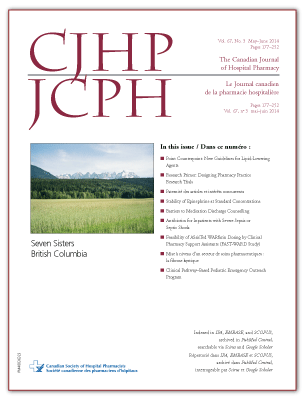Stability of Epinephrine at Standard Concentrations
DOI:
https://doi.org/10.4212/cjhp.v67i3.1356Keywords:
epinephrine, standard concentration, stability, épinéphrine, concentration standard, stabilitéAbstract
ABSTRACT
Background: To minimize medication errors, standard concentrations are recommended for medications intended for continuous infusion in pediatric patients. Premixing of epinephrine (commonly used to manage septic shock in children) would improve timeliness, safety, and costeffectiveness. However, information about the stability of epinephrine at standard concentrations is limited.
Objectives: To evaluate the stability of epinephrine in 5% dextrose in water at standard concentrations and to extend its expiration date after storage in infusion bags at 4°C and 25°C for up to 30 days.
Methods: A total of 6 infusion bags were prepared with 200 mL of epinephrine solution, 2 bags for each of 3 standard concentrations (25, 50, and 100 μg/mL). Three bags (one for each concentration) were stored under refrigeration (4°C), and the remaining 3 bags were stored at room temperature (25°C). Physical characteristics (including pH, colour, and presence of precipitate) were evaluated daily for the first 14 days and every 1 to 5 days thereafter until day 30. Three 1.5-mL samples were collected from each bag immediately after preparation (time 0), every 24 h (at 24 h, 48 h, 72 h, 96 h, etc.) for the first 14 days, and every 1 to 5 days thereafter until day 30. Each sample was analyzed by stability-indicating high-performance liquid chromatography. A solution was considered stable if it maintained at least 90% of its initial concentration.
Results: No notable changes in pH, colour, or precipitation were observed in any of the solutions after storage at 4°C or 25°C for up to 30 days. All formulations maintained more than 95% of the initial epinephrine concentration on day 30. In addition, the calculated lower limit of the 95% confidence interval indicated that 93% or more of the initial concentration remained on day 30.
Conclusions: Preparations of epinephrine were stable for up to 30 days, with or without refrigeration. Because stability alone does not guarantee bioavailability or efficacy of a drug, future clinical studies are recommended to evaluate the pharmacokinetics and pharmacodynamics of these formulations.
RÉSUMÉ
Contexte : Afin de réduire au maximum les erreurs de médication, il est recommandé d’utiliser des concentrations standards pour les médicaments administrés par perfusion continue aux enfants. La préparation préalable des solutions d’épinéphrine (couramment utilisée pour traiter le choc septique chez l’enfant) permettrait d’améliorer la rapidité d’action, la sécurité et le rapport coût-efficacité. Il existe malheureusement peu de données portant sur la stabilité de solutions d’épinéphrine de concentrations standards.
Objectifs : Évaluer la stabilité de l’épinéphrine de concentrations standards dans du dextrose à 5 % dans l’eau et augmenter la durée de conservation des solutions entreposées dans des sacs pour perfusion à 4 °C et à 25 °C jusqu’à 30 jours.
Méthodes : Six sacs pour perfusion contenant 200 mL d’une solution d’épinéphrine ont été préparés, soit une paire de chacune des trois concentrations standards (25, 50 et 100 μg/mL). Trois sacs ont été conservés au réfrigérateur (4 °C) et les trois autres ont été entreposés à la température ambiante (25 °C). Les propriétés physiques (notamment le pH, la couleur et la présence de précipité) ont été évaluées quotidiennement les 14 premiers jours, puis à des intervalles de 1 à 5 jours jusqu’au jour 30. Trois échantillons de 1,5 mL ont été recueillis de chaque sac immédiatement après la préparation de la solution (temps 0), puis toutes les 24 heures (24 h, 48 h, 72 h, 96 h, etc.) pendant les 14 premiers jours et ensuite à des intervalles de 1 à 5 jours jusqu’à la fin de la période de 30 jours. Chaque échantillon a été analysé à l’aide d’une épreuve mesurant la stabilité par chromatographie liquide haute performance. Une solution était considérée comme stable si elle conservait au moins 90 % de sa concentration initiale.
Résultats : Aucun précipité et aucun changement notable du pH ou de la couleur n’ont été observés dans l’ensemble des solutions après un entreposage à 4 °C ou à 25 °C d’une période de 30 jours. Toutes les préparations avaient conservé plus de 95 % des concentrations initiales d’épinéphrine au jour 30. De plus, la limite inférieure de l’intervalle de confiance à 95 % indiquait que les préparations avaient conservé 93 % ou plus de leurs concentrations initiales au jour 30.
Conclusions : Les préparations d’épinéphrine sont demeurées stables pendant les 30 jours, qu’elles aient été réfrigérées ou non. Comme la stabilité seule ne garantit pas la biodisponibilité ou l’efficacité d’un médicament, d’autres études cliniques sont recommandées afin d’évaluer le comportement pharmacocinétique et pharmacodynamique de ces préparations.
Downloads
Published
Issue
Section
License
Copyright © Canadian Society of Healthcare-Systems Pharmacy.
After publication of a manuscript in the CJHP, the authors of the manuscript must obtain written permission from the CSHP (publications@cshp.ca) before reproducing any text, figures, tables, or illustrations from the work in future works of their own. If a submitted manuscript is declined for publication in the CJHP, all said rights shall revert to the authors. Please note that any forms (e.g., preprinted orders and patient intake forms) used by a specific hospital or other health care facility and included as illustrative material with a manuscript are exempt from this copyright transfer. The CJHP will require a letter from the hospital or health care facility granting permission to publish the document(s).










